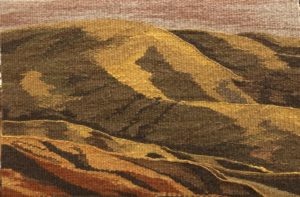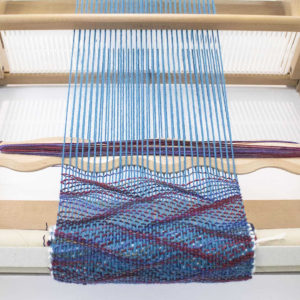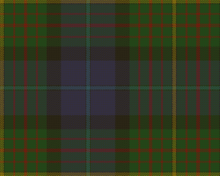Thrums: Bits and Bobs
Browsing the web is my favorite thing to do, while having my morning coffee. When the coffee is done, though, I step away from the keyboard, stretch and get some fresh air. Here are a few things I thought might interest you:
Tapestry Weavers West just wrapped up an awesome exhibition, SHIFT, in San Rafael. The show highlighted many of the talented members’ works. They also announce some upcoming workshops. See their website for details and membership: https://www.tapestryweaverswest.org/

Yonat Michaelov, California Summer Hills, 2021 (courtesy Tapestry Weavers West)

Waving Weaving,
Handwoven magazine.
https://handwovenmagazine.com/wavy-weaving/
In Handwoven magazine, Liz Evans shares her tips and techniques on how to use a wavy shuttle to beat diagonals, stacked waves, offset waves and more. She also shares tips for wet finishing to carefully preserve the pattern.
I’ve recently become interested in sashiko methods and found Selvedge magazine recently announced an online workshop scheduled for late May on Sashiko Stitching with Atsushi Futatsushi. You can get more information here: Selvedge Sashiko Workshop

April 6 was worldwide Tartan Day. While tartans were developed in Scotland to designate clan affiliation, the world has embraced the colorful plaids and many countries now have their own tartan. The official State Tartan is generally described as a pattern or sett consisting of alternate squares of meadow-green and Pacific blue that are separated and surrounded by narrow charcoal bands. The squares of meadow-green are divided by a gold seam that is supported by charcoal lines on each side. There are three redwood stripes, the middle of which is broader, that are added to each side of the gold seam. The Pacific blue square is divided by a sky-blue stripe, which is supported on each side by charcoal lines.
The tartan is specifically defined by the following weave code:
Y..B..G…S..G…S..G…S..G…B…A…B..K… Ancient Colors
8..2..20..4..20..8..20..4..20..32..56..2..8… Full Pivots
This weave code means that the threads begin with 8 threads of yellow, followed by 2 threads of black, 20 threads of green, 4 threads of scarlet, 20 threads of green, 8 threads of scarlet, 20 threads of green, 4 threads of scarlet, 20 threads of green, 32 threads of black, 56 threads of azure, 2 threads of black, and 8 threads of sky blue. At that point the weave pivots and returns, beginning with 2 threads of black, and continuing the sequence in reverse order through 8 threads of yellow, at which point it pivots back again.
Wikipedia
Interested in historical handsewing wovens? Read a thesis by Sarah Elizabeth Woodyard here . Sarah apprenticed at the Millinery Shop in Colonial Williamsburg and went on to complete her studies in Material Culture at the University of Alberta.
Selvedge magazine
In partnership with the Royal School of Needlework, the Textile and Fashion Museum in London has opened a new show called From Crown to Catwalk. Commemorating the School’s 150-year anniversary. For a gallery of the exhibit, go here: https://fashiontextilemuseum.org
Ply magazine’s next issue is all about loft.
As the war continues in Ukraine, our attention goes to the impacts of The ethnic Hutsul weavers of Ukraine, highlighted in this YouTube clip https://youtu.be/Lf2QS80po8U